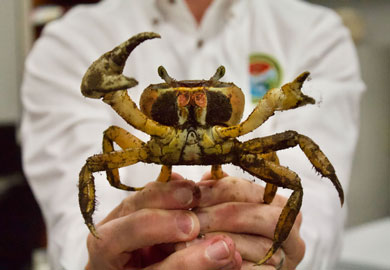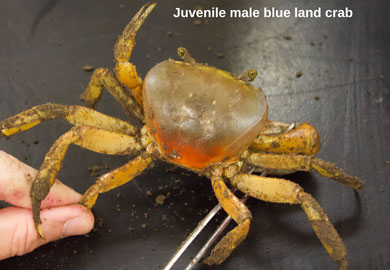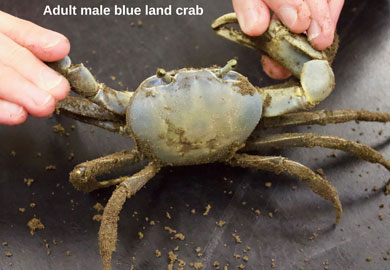SCDNR News
Report sightings of non-native blue land crab
September 2, 2022

If you live near the South Carolina coast and encounter what looks like an enormous fiddler crab, South Carolina Department of Natural Resources (SCDNR) biologists want you to snap a photo.
After a spate of recent reports of the blue land crab (Cardisoma guanhumi), SCDNR biologists are asking South Carolinians to help them learn more about where the non-native species is spreading by reporting any sightings.
The blue land crab is native along the Atlantic coast from Brazil to South Florida, but occasional sightings of the large crabs have been reported in South Carolina since 2008. Researchers do not yet know the extent of the crab’s distribution in South Carolina nor its impact on the environment and other wildlife. Whether the species arrived through natural expansion of its range or human-mediated sources is also not clear.

Young blue land crabs, like this male, can range in color from orange to dark brown to purple. (Photo: E. Weeks/SCDNR)
Despite their name, the crabs vary widely in color. Adult males tend to have the characteristic blue-gray coloring, but females can also be white or ash-gray, and juveniles can range from orangish to dark brown to purple. They're also unusually long-lived and slow-growing among crabs, reaching maturity at four years of age and surviving up to eleven years.
Males can be differentiated from females by the shape of the 'apron' on their undersides. Males have a thin, pointy apron, while females have a wide, domed apron.

Adult male blue land crabs have one large, powerful claw and tend to grow larger than females. (Photo: E. Weeks/SCDNR)
Blue land crabs are eaten in some parts of their native range, but they’re difficult to catch. In addition to their speed at retreating into burrows deep below ground, the crabs possess a large claw that they can use to dexterously defend themselves.
If you see one of these crabs, SCDNR biologists encourage you snap a photo and report your sighting at the link below. Biologists suspect the crabs may be more visible lately due to the heavy rains South Carolina's coast has experienced, which can drive them out of their burrows.



